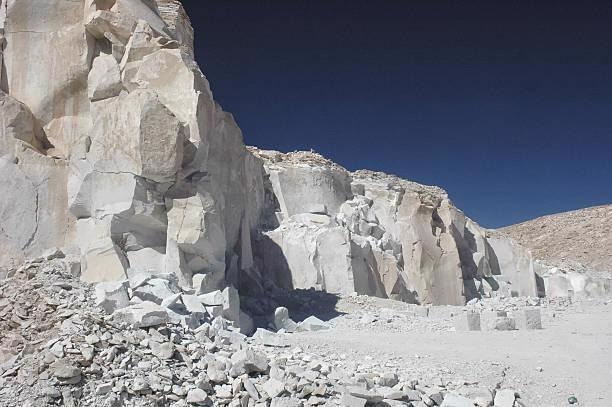Gypsum performance is impacted by a wide range of factors, with particle size distribution consistently regarded as one of the most significant. This article explores the use of a laser particle size analyzer to investigate gypsum’s particle size distribution both prior to and following a grinding process.

Image Credit: Bettersize Instruments Ltd.
Measurements presented here highlight the variation in particle size distribution between two gypsum samples, showcasing the excellent repeatability of the particle size analyzer instrument.
Performance of Gypsum Depends on Particle Size Distribution
Gypsum has been used in a diverse array of applications, ranging from the construction of ancient Roman architecture to use as a medicinal agent in traditional Chinese medicine.1 Gypsum may be extracted from evaporite or mined from gypsite.
Nonetheless, construction remains the primary application area of gypsum. Typical gypsum processing in the construction industry begins with crushing a preliminary fragmentation, followed by grinding and heating processes, which is the key stage of the production of plaster (hemihydrate gypsum) – a popular material due to its ability to set in a hard mass following the addition of water.
Factors that may impact the properties of gypsum include its particle size distribution, the amount of water added or the type of filler used.
In practical terms, key performance parameters are reliant on optimum particle size distribution, for example, setting time, compressive strength or density.2 Control of particle size is, therefore, an essential factor in gypsum production.

Image Credit: Bettersize Instruments Ltd.
Bettersizer ST as a Key Quality Control Tool
Bettersizer ST is a leading particle size analyzer that is ideally suited to quality control applications. The instrument guarantees excellent product performance due to its robust laser diffraction technology and patented DLOS optical system.
This robust combination of features facilitates rapid measurements while ensuring repeatable and accurate results. In the example presented here, Bettersizer ST was used to measure two commercial gypsum powders applied in the construction industry.
Particle Size Distribution Measurement of Gypsum
To facilitate their measurement, samples were dispersed under ethanol in a corrosion-resistant circulation tank. The instrument was able to return measurement in a graphical format within seconds.
One sample had been subjected to the grinding process, while the other had not. Figure 1 displays the particle size distribution of the two samples as reported by the Bettersizer ST.
The range of particle size distributions was found to be relatively similar, but it was noted that finer particles were present following the grinding process.
Particle size uniformity was good prior to grinding, and while the average particle size did become smaller after the grinding process, this did not yield an even distribution of particle sizes.
These findings may suggest that the grinding process was not fully complete or sufficiently thorough, as highlighted by numerous particles being relatively large in the ground sample.
The example presented here highlights the Bettersizer ST’s ability to deliver rapid and accurate measurements of particle size distribution – a key factor in ensuring robust quality control processes of materials such as gypsum.

Figure 1. Particle size distribution of gypsum before and after grinding process measured with Bettersizer ST. Image Credit: Bettersize Instruments Ltd.
Excellent Measurement Repeatability
Repeatability is arguably one of the most important parameters of any particle size analyzer. Figure 2 displays the results from the Bettersizer ST for a sample that was obtained from ground gypsum and measured five times.
The results show that the five distribution curves almost entirely overlap, confirming the excellent repeatability of measurements performed with the Bettersizer ST.
Table 1 displays corresponding repeatability values for D10, D50 and D90, highlighting that the particle size of gypsum was experimentally determined with variability of under 0.5%.

Figure 2. Particle size distribution of five measurements of a ground sample. Image Credit: Bettersize Instruments Ltd.
Table 1. Comparison of D10, D50 and D90 of five measurements and corresponding repeatabilities. Source: Bettersize Instruments Ltd.
| Sample |
D10 (μm) |
D50 (μm) |
D90 (μm) |
| Gypsum 1-1 |
1.654 |
15.34 |
59.31 |
| Gypsum 1-2 |
1.646 |
15.18 |
58.76 |
| Gypsum 1-3 |
1.653 |
15.33 |
59.42 |
| Gypsum 1-4 |
1.651 |
15.31 |
59.19 |
| Gypsum 1-5 |
1.652 |
15.28 |
59.26 |
| Repeatability |
0.19% |
0.42% |
0.43% |
Conclusion
Using the Bettersizer ST, it was possible to rapidly and accurately determine the particle size distribution of two gypsum samples.
The instrument demonstrated excellent repeatability and reliability, highlighted by the repeated measurement of a ground sample and a comparison of the resulting distribution curves.
Bettersizer ST is an ideal particle size analyzer for quality control applications due to its ability to provide reliable, accurate results via convenient, rapid measurements.
References
- Shizhen, L. (1596) Compendium of Materia Medica (Bencao Gangmu). Reprint, Oakland: UC Press, 2021.
- Jérôme A.; Sylvain M.; Solene T.; Éric M.; Layla S. In-situ X-ray tomographic monitoring of gypsum plaster setting. Cem. Concr. Res. 2016, 82, 107-116.
Acknowledgments
Produced from materials originally authored by Wenjian Zhou from Bettersize Instruments Ltd.

This information has been sourced, reviewed and adapted from materials provided by Bettersize Instruments Ltd.
For more information on this source, please visit Bettersize Instruments Ltd.
